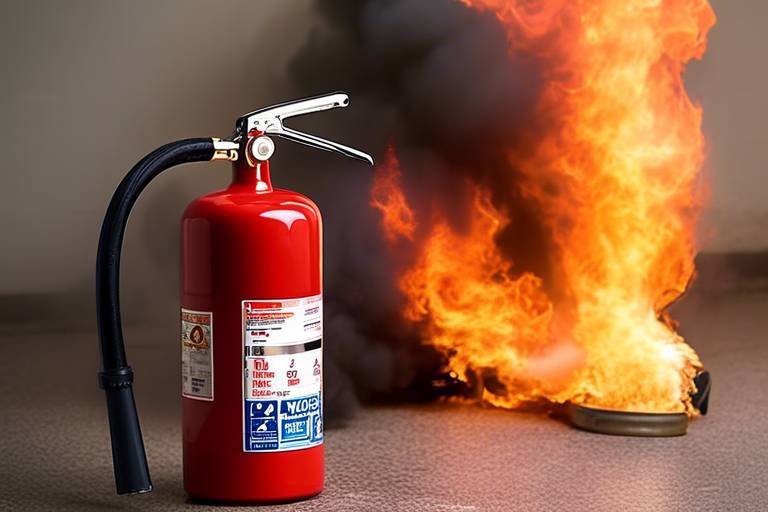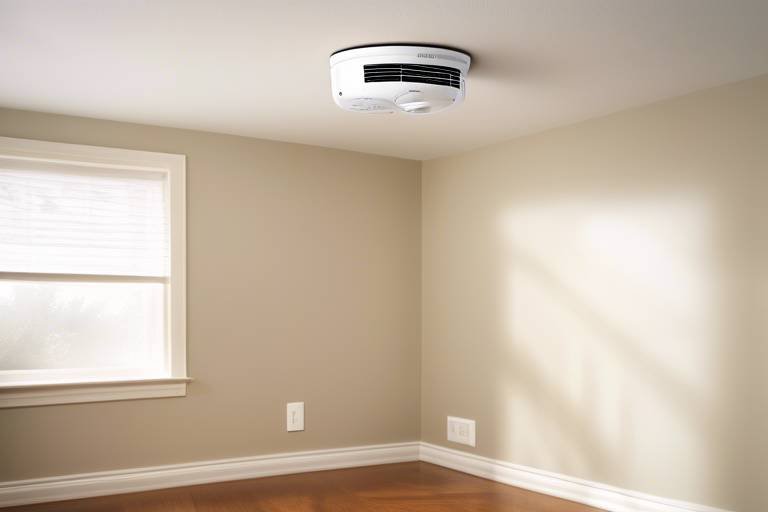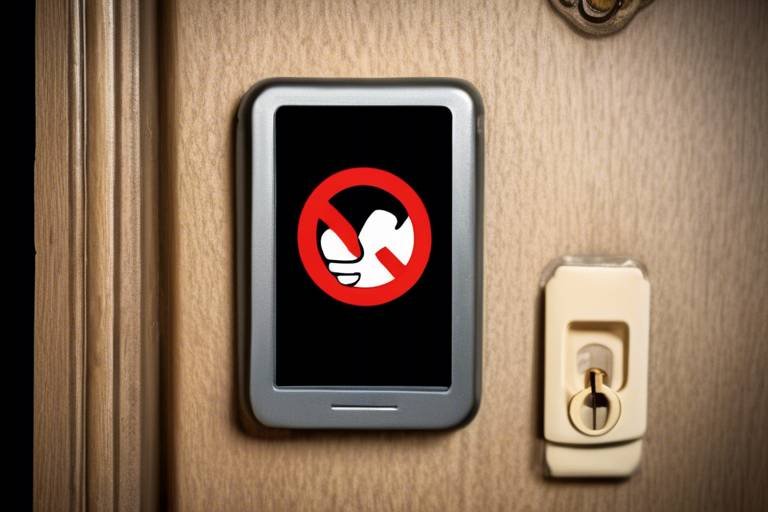Testing Your Fire Extinguishers - How and Why You Should Do It
Fire extinguishers are often the unsung heroes of safety equipment, quietly standing by until they are needed most. But how often do we really think about them? Just like a trusty umbrella that you only remember when it rains, fire extinguishers need regular attention to ensure they’re ready to spring into action when a fire breaks out. In this article, we’ll dive into the importance of regularly testing fire extinguishers, the procedures involved, and the benefits of maintaining these crucial safety devices in your home or workplace. After all, when it comes to safety, it’s better to be proactive than reactive!
Fire extinguishers are not one-size-fits-all; they come in various types, each designed for specific fire classes. Understanding their functions and classifications is essential for effective fire safety management. For instance, did you know that:
- Class A extinguishers are for ordinary combustibles like wood and paper?
- Class B extinguishers tackle flammable liquids such as gasoline and oil?
- Class C extinguishers are specifically for electrical fires?
- Class D extinguishers are used for combustible metals?
Having the right extinguisher on hand is crucial. Imagine trying to put out a grease fire with water – it would only make things worse! Knowing what type of extinguisher you have and where it’s located can mean the difference between a small incident and a full-blown disaster.
Regular testing of fire extinguishers ensures they are functional and reliable in emergencies. Just like checking your smoke detectors, keeping your extinguishers in top shape can save lives. Here are some critical reasons why adhering to testing schedules is essential:
- Peace of Mind: Knowing your fire extinguishers are operational provides a sense of security.
- Compliance: Many workplaces have regulations that require regular inspections.
- Cost-Effectiveness: Maintaining extinguishers can prevent costly replacements down the line.
In essence, treating your fire extinguishers with the care they deserve is a small investment in your safety that pays off in a big way.
Many jurisdictions have legal requirements for fire extinguisher maintenance. These regulations often outline testing frequency and compliance standards to help you avoid potential penalties. For example, in some areas, fire extinguishers must be inspected annually, while others may require monthly checks. It’s essential to familiarize yourself with your local laws to ensure you’re compliant. Ignoring these regulations can lead to hefty fines and, more importantly, jeopardize safety in an emergency.
Routine inspections are crucial for ensuring your fire extinguishers are ready when you need them. Here’s a quick step-by-step guide on how to conduct thorough inspections effectively:
- Check the pressure gauge: Ensure it’s in the green zone.
- Inspect the seal: Make sure the tamper seal is intact.
- Examine the physical condition: Look for dents, rust, or leaks.
- Verify the inspection tag: Ensure it’s up-to-date and not expired.
By following these steps, you can catch potential issues before they become serious problems.
Keeping accurate records of inspections and maintenance is crucial for accountability. Documentation not only helps with compliance but also serves as a valuable reference during safety audits. Consider creating a simple log that includes:
- Date of inspection
- Condition of the extinguisher
- Any maintenance performed
By maintaining this documentation, you ensure that you’re always prepared and can quickly demonstrate compliance if required.
During testing, various issues can arise, such as low pressure or expired units. Some common problems include:
- Low Pressure: If the gauge is not in the green zone, the extinguisher may not function properly.
- Expired Units: Check the expiration date; an expired extinguisher is as good as useless.
- Physical Damage: Dents or corrosion can compromise the integrity of the unit.
Addressing these issues promptly can make all the difference in an emergency situation.
Deciding between DIY testing and hiring professionals can significantly impact safety and compliance. While some minor checks can be done by yourself, certain aspects are best left to the experts. For instance, professional services ensure thorough assessments and compliance with legal standards.
Engaging professional services for testing has several advantages:
- Thorough Assessments: Professionals know what to look for and can catch issues you might miss.
- Legal Compliance: They are familiar with local regulations and ensure you meet all requirements.
- Peace of Mind: Knowing that an expert has inspected your equipment can alleviate stress.
There are certain circumstances where DIY testing is appropriate, particularly for minor checks. If you’re comfortable and knowledgeable, you can perform monthly inspections as outlined earlier. However, always prioritize safety and call in the professionals if you notice anything concerning. Remember, it’s better to be safe than sorry!
Q: How often should I test my fire extinguishers?
A: It’s recommended to conduct monthly visual inspections, while professional testing should occur at least annually.
Q: What do I do if my fire extinguisher is expired?
A: If your extinguisher is expired, it should be replaced immediately to ensure safety.
Q: Can I refill my fire extinguisher myself?
A: It’s best to have fire extinguishers refilled by a professional to ensure they are properly serviced and compliant.

Understanding Fire Extinguishers
When it comes to fire safety, understanding fire extinguishers is crucial. These devices are not just random cans of foam or powder; they are specialized tools designed to combat specific types of fires. Imagine a fire extinguisher as a superhero, each with its own unique powers tailored to tackle different villains—fires of various classes. The most common types of fire extinguishers include:
- Class A: Effective against ordinary combustibles like wood, paper, and cloth.
- Class B: Designed for flammable liquids such as gasoline, oil, and grease.
- Class C: Used for electrical fires, which can be particularly dangerous.
- Class D: Specifically for combustible metals, often found in industrial settings.
- Class K: Targets kitchen fires, especially those involving cooking oils and fats.
Each class of fire extinguisher uses different agents to extinguish flames, making it essential to select the right one for your needs. For example, using a Class B extinguisher on a Class A fire could lead to a disastrous outcome, as it might not effectively put out the flames. Think of it like trying to use a water hose to put out an oil fire—it's simply not going to work!
In addition to knowing the types, understanding the functions of fire extinguishers is equally important. Most extinguishers are designed to be easy to operate, but they still require some knowledge to use effectively. The acronym P.A.S.S. can help you remember the steps:
- P: Pull the pin at the top of the extinguisher.
- A: Aim the nozzle at the base of the fire.
- S: Squeeze the handle to release the extinguishing agent.
- S: Sweep the nozzle from side to side until the fire is out.
It's also essential to regularly check your fire extinguishers to ensure they are in good working condition. Look for any signs of damage, check the pressure gauge, and make sure the pin is intact. Understanding these elements not only empowers you but also plays a pivotal role in maintaining safety in your home or workplace.
In summary, fire extinguishers are not one-size-fits-all. Each type serves a specific purpose, and knowing how to use them can be the difference between a small incident and a full-blown disaster. So, take the time to familiarize yourself with these life-saving devices; your future self will thank you!

Importance of Regular Testing
When it comes to fire safety, regular testing of fire extinguishers is not just a recommendation; it's a necessity. Imagine you're in a situation where a fire breaks out. The last thing you want is to grab an extinguisher that doesn't work. Regular testing ensures that your fire extinguishers are always in top-notch condition, ready to tackle any emergency that may arise. Think of it like maintaining your car; you wouldn't want to drive a vehicle that hasn't been serviced in years, right? The same principle applies here.
One of the most critical reasons for adhering to a strict testing schedule is to guarantee the reliability of these life-saving devices. Fire extinguishers can be the difference between a small, manageable fire and a catastrophic disaster. By regularly checking them, you can ensure that they are fully charged, have not expired, and are free from any physical damage. This proactive approach not only protects lives but also minimizes property damage.
Moreover, regular testing is often tied to legal requirements. Many jurisdictions have stringent regulations regarding fire safety equipment. Failing to comply with these laws can lead to hefty fines or even legal action in some cases. It’s crucial to stay informed about the testing frequency mandated by local laws. For instance, some areas may require monthly checks, while others might stipulate quarterly or annual inspections. Keeping up with these regulations ensures that you are not only safe but also compliant with the law.
In addition to legal compliance, regular testing also plays a vital role in insurance matters. Many insurance policies require proof of regular maintenance for fire safety equipment. If a fire occurs and you cannot provide documentation of your extinguisher's testing, you might face challenges when filing a claim. Thus, maintaining a schedule for testing and keeping records can save you from potential headaches down the line.
So, how can you ensure that your fire extinguishers are regularly tested? Here’s a simple checklist to keep in mind:
- Check the pressure gauge to ensure it’s in the green zone.
- Inspect the seal for any signs of tampering or damage.
- Look for physical damage such as dents or rust.
- Ensure that the extinguisher is easily accessible and visible.
In summary, the importance of regular testing of fire extinguishers cannot be overstated. It’s about ensuring safety, compliance, and peace of mind. By taking the time to test your extinguishers regularly, you are making a significant investment in the safety of your home or workplace. Remember, a little effort now can prevent a disaster later!
Q: How often should I test my fire extinguishers?
A: It’s recommended to check your fire extinguishers monthly and have them professionally serviced annually.
Q: What should I do if my fire extinguisher is low on pressure?
A: If the pressure gauge indicates low pressure, it’s best to recharge or replace the extinguisher immediately.
Q: Are there any legal requirements for fire extinguisher testing?
A: Yes, many jurisdictions have specific regulations regarding the maintenance and testing of fire extinguishers. Check with your local fire department for details.

Legal Requirements
When it comes to fire safety, understanding the surrounding fire extinguisher maintenance is crucial. Many jurisdictions have established regulations that outline how often these safety devices must be tested and inspected. Ignoring these laws can lead to serious consequences, including hefty fines or, worse, increased risk during a fire emergency. It’s not just about having an extinguisher on hand; it’s about ensuring it’s fully operational when you need it the most.
Typically, the legal framework requires fire extinguishers to be inspected at least once a year by a qualified technician. However, there are additional checks that you, as a property owner, should perform more frequently. For instance, a visual inspection can be done monthly to ensure that the extinguisher is in its designated spot, has not been tampered with, and shows no visible signs of damage. Here’s a quick overview of common legal requirements:
| Requirement | Description |
|---|---|
| Annual Inspection | Must be conducted by a certified professional to ensure functionality. |
| Monthly Visual Checks | Property owners should conduct basic checks to ensure the extinguisher is accessible and undamaged. |
| Hydrostatic Testing | Required every 5 to 12 years depending on the type of extinguisher. |
It's essential to familiarize yourself with the specific laws in your area, as they can vary significantly from one location to another. Some regions may require additional documentation or certifications, while others might have more relaxed standards. Ignorance of these laws is not an excuse, and failing to comply can lead to serious repercussions.
Moreover, keeping your fire extinguishers compliant not only protects you legally but also enhances safety for everyone in your premises. Imagine the chaos of a fire breaking out and realizing that your extinguishers are not up to code. It's a nightmare scenario that can be easily avoided with proper diligence.
In summary, understanding and adhering to the legal requirements for fire extinguisher maintenance is not just a matter of compliance; it’s a vital part of ensuring safety. Regular inspections and documentation will not only keep you safe but also provide peace of mind knowing that you are doing everything possible to protect your loved ones or employees.
- How often should I test my fire extinguishers? It is recommended to have them professionally inspected at least once a year, with monthly visual checks performed by the property owner.
- What should I do if my fire extinguisher is low on pressure? If the pressure gauge indicates low pressure, it’s essential to have the extinguisher serviced or replaced immediately.
- Are there penalties for not maintaining fire extinguishers? Yes, failing to comply with local fire safety regulations can result in fines and increased liability in the event of an emergency.
- Can I perform inspections myself? While you can conduct basic visual inspections, full servicing should be done by a certified professional.

Inspection Procedures
When it comes to ensuring your fire extinguishers are ready to spring into action at a moment's notice, regular inspections are non-negotiable. Think of these inspections as a health check-up for your fire safety equipment. Just like you wouldn’t ignore your body’s signals, you shouldn’t overlook the signs that your fire extinguishers might need attention. An effective inspection involves several key steps that should be performed at least once a month, or more frequently depending on the environment in which the extinguishers are kept.
First, start by visually examining the fire extinguisher to ensure it is in its designated location and easily accessible. The last thing you want in an emergency is to fumble around looking for it. Make sure that it is mounted correctly, whether it's on a wall or in a cabinet, and that it hasn’t been moved or obstructed by any objects. Next, check the pressure gauge; it should be in the green zone. If the needle is in the red, it indicates that the extinguisher is either overcharged or undercharged, and it may need to be serviced.
Another critical aspect of the inspection is to check the seal and pin. The tamper seal should be intact, and the pin should be in place. If the seal is broken or the pin is missing, it could mean the extinguisher has been tampered with or used. Additionally, inspect the extinguisher’s body for any signs of physical damage, such as rust, dents, or leaks. These imperfections can compromise the effectiveness of the extinguisher. If you find any issues, it’s best to have the extinguisher serviced by a professional.
Finally, don’t forget to check the expiration date on the label. Fire extinguishers typically have a lifespan of 5 to 15 years, depending on the type. If it’s nearing the end of its life, consider replacing it. Keeping a detailed log of inspections can be incredibly beneficial. Not only does it help you stay organized, but it also provides a record for compliance with safety regulations. You can create a simple table to track inspection dates, findings, and any actions taken:
| Date of Inspection | Findings | Actions Taken |
|---|---|---|
| 01/01/2023 | Pressure gauge in green zone | No action needed |
| 02/01/2023 | Seal intact, no damage | No action needed |
| 03/01/2023 | Low pressure | Serviced by professional |
By following these procedures, you can ensure that your fire extinguishers are not just decorative items on the wall but reliable tools that could save lives in an emergency. Remember, when it comes to fire safety, it’s always better to be proactive than reactive!

Documentation and Record Keeping
When it comes to fire extinguisher maintenance, are not just administrative tasks; they are vital components of a comprehensive fire safety strategy. Imagine being in a situation where you need to use your fire extinguisher, but when you reach for it, you have no idea when it was last inspected or serviced. That’s a nightmare scenario waiting to happen! Keeping detailed records ensures that you know the status of your equipment and can provide proof of compliance during safety audits.
To maintain effective documentation, you should establish a systematic approach. Start by creating a fire extinguisher log that includes essential information such as:
- The location of each fire extinguisher
- Model and serial number
- Date of purchase
- Inspection dates
- Maintenance and service records
- Expiration dates for any disposable components
This log should be easily accessible and updated regularly. Consider using a digital format for easy tracking and retrieval. There are many software solutions available that can help automate reminders for upcoming inspections, making your life significantly easier. By having this information at your fingertips, you can quickly assess whether your fire extinguishers are compliant with local regulations and ready for action.
Moreover, it’s important to keep copies of any service reports or inspection certificates. These documents serve as proof that your equipment is regularly maintained and can protect you from potential liabilities in case of an emergency. You wouldn’t want to be caught off guard, right?
In summary, effective documentation and record keeping for fire extinguishers not only enhance safety but also ensure compliance with legal requirements. By maintaining accurate records, you can rest easy knowing that you are doing everything possible to protect yourself, your family, or your employees. Just remember, a well-documented fire safety plan is like a safety net; it’s there to catch you when things go wrong.
- How often should I inspect my fire extinguishers? - It's recommended to inspect your fire extinguishers monthly and have them serviced annually by a professional.
- What should I do if my fire extinguisher is expired? - If your fire extinguisher is expired, it should be replaced immediately to ensure safety during emergencies.
- Can I perform maintenance on my fire extinguisher myself? - While you can do basic inspections, any maintenance or servicing should be performed by a certified professional to ensure compliance and safety.

Common Issues Found During Testing
When it comes to fire extinguishers, just like any other safety device, they can develop issues over time that may compromise their effectiveness. During routine testing, you might encounter several common problems that need immediate attention. One of the most frequent issues is low pressure. This can happen for various reasons, such as leaks or simply because the extinguisher hasn't been serviced in a while. A low-pressure gauge is a red flag indicating that the extinguisher may not function properly in an emergency. Always check the gauge and ensure it’s within the green zone, which signifies it’s ready for use.
Another common problem is expired extinguishers. Fire extinguishers have a limited lifespan, typically ranging from 5 to 15 years, depending on the type. If you notice that your extinguisher is past its expiration date, it’s crucial to replace it immediately. An expired extinguisher is essentially a useless piece of equipment, and relying on it during a fire could have disastrous consequences.
Additionally, physical damage can also be a concern. During testing, inspect the extinguisher for any signs of dents, rust, or corrosion. Such damage can weaken the unit, making it less reliable when you need it the most. If you find any significant damage, it’s advisable to replace the extinguisher rather than risk using a compromised unit.
Don’t forget to check the seal and pin. The tamper seal should be intact, and the pin should be securely in place. If the seal is broken or the pin is missing, it could indicate that the extinguisher has been tampered with or used previously. In such cases, it’s essential to have the extinguisher serviced or replaced to ensure it’s ready for action.
Lastly, ensure that the nozzle and hose are clear and free from blockages. Sometimes, dust, debris, or even insects can obstruct the nozzle, which would prevent the extinguisher from discharging properly. A simple visual inspection can help identify any obstructions, and cleaning the nozzle can often resolve the issue.
In summary, here’s a quick overview of the common issues you might find during testing:
- Low pressure
- Expired units
- Physical damage
- Broken seals or missing pins
- Blocked nozzles and hoses
By being vigilant and addressing these issues promptly, you can ensure that your fire extinguishers are always ready to protect you and your loved ones in an emergency. Remember, regular testing is not just a recommendation; it’s a vital part of fire safety management that can save lives.
Q: How often should I test my fire extinguishers?
A: It's recommended to test your fire extinguishers at least once a month and have them professionally serviced annually.
Q: Can I refill my fire extinguisher myself?
A: It’s generally not advisable to refill your fire extinguisher yourself. Always consult a professional service to ensure it’s done safely and correctly.
Q: What should I do if my fire extinguisher is expired?
A: If your fire extinguisher is expired, it should be replaced immediately. Do not attempt to use an expired unit in an emergency.
Q: Where should I keep my fire extinguishers?
A: Fire extinguishers should be easily accessible, ideally placed near potential fire hazards, and in common areas like kitchens and garages.
Q: How can I tell if my fire extinguisher needs servicing?
A: Look for signs such as low pressure, physical damage, expired date, or broken seals. If you notice any of these issues, it’s time for servicing.

DIY vs. Professional Testing
When it comes to testing fire extinguishers, the debate between doing it yourself (DIY) and hiring professionals can be a hot topic. On one hand, some people feel confident in their ability to perform basic checks and maintenance on their own extinguishers. After all, how hard can it be to check a pressure gauge or inspect for physical damage? However, on the other hand, relying on professional services can provide a level of assurance and compliance that DIY testing may lack. So, which route should you take? Let's explore the pros and cons of both options.
DIY testing can be a viable option if you have a good understanding of how fire extinguishers work and the specific checks that need to be performed. For instance, you can easily check the pressure gauge to ensure it’s within the operational range, inspect the seals to confirm they haven’t been tampered with, and visually examine the extinguisher for any signs of corrosion or damage. However, while these tasks may seem straightforward, they can sometimes be misleading. A small issue that goes unnoticed could lead to a much larger problem in an emergency situation.
On the flip side, hiring professionals brings a wealth of experience and knowledge to the table. They are trained to identify issues that the average person might overlook. For example, they can perform a thorough inspection that includes checking the expiration date, testing the extinguisher’s discharge mechanism, and ensuring that it meets all local regulations. Furthermore, professionals often provide a detailed report of their findings, which can be invaluable for compliance and safety audits.
To help you weigh your options, here’s a quick comparison of DIY testing versus professional services:
| Aspect | DIY Testing | Professional Testing |
|---|---|---|
| Cost | Generally lower, but may incur hidden costs if issues arise | Higher upfront cost, but potentially saves money in the long run |
| Expertise | Requires some knowledge and experience | Trained professionals with extensive knowledge |
| Thoroughness | May miss critical issues | Comprehensive inspections with detailed reporting |
| Compliance | May not meet all local regulations | Ensures compliance with legal standards |
Ultimately, the decision should be based on your level of comfort, the complexity of the inspection, and the specific regulations in your area. If you feel confident in your abilities and are only performing minor checks, DIY testing might be sufficient. However, for a thorough assessment and peace of mind, especially in commercial settings, hiring professionals is often the best route. Remember, when it comes to fire safety, it’s always better to be safe than sorry!
Q: How often should fire extinguishers be tested?
A: Fire extinguishers should be inspected monthly and undergo a more thorough professional inspection annually.
Q: What should I do if my fire extinguisher is expired?
A: Expired fire extinguishers should be replaced immediately to ensure you have a functional device in case of an emergency.
Q: Can I refill my fire extinguisher myself?
A: Refilling a fire extinguisher should only be done by a certified professional to ensure it is done correctly and safely.

Benefits of Professional Services
When it comes to ensuring the safety of your home or workplace, the benefits of hiring professional services for fire extinguisher testing cannot be overstated. These experts bring a wealth of knowledge and experience to the table, ensuring that your fire extinguishers are not only compliant with legal standards but also fully operational when you need them the most. Imagine facing a fire emergency only to discover that your extinguisher is ineffective; this nightmare scenario can be avoided by relying on professionals who know exactly what to look for.
One of the primary advantages of engaging professional services is their thoroughness. Trained technicians have the skills to conduct comprehensive inspections that go beyond a simple visual check. They use specialized tools and techniques to assess the condition of your extinguishers, including:
- Pressure gauge readings
- Seal integrity
- Physical damage or corrosion
- Expiration dates
Moreover, these professionals stay updated with the latest regulations and standards. This means they can ensure that your fire extinguishers meet all legal requirements, thus protecting you from potential fines and liabilities. In many jurisdictions, failing to comply with fire safety regulations can result in severe penalties, so having an expert on your side can save you from unnecessary headaches.
Another key benefit is the peace of mind that comes with knowing your fire safety equipment is in expert hands. You can focus on your daily activities without the constant worry of whether your extinguishers will work in an emergency. A professional service will not only test and maintain your extinguishers but also provide you with detailed reports on their condition, which is essential for any safety audits or inspections.
Finally, professional services often offer ongoing maintenance plans. This means you can schedule regular check-ups for your fire extinguishers, ensuring they are always in top condition. Think of it as a health plan for your safety equipment—just as you wouldn't neglect your health, you shouldn't neglect your fire safety measures. By investing in professional services, you are making a proactive choice that prioritizes safety and compliance.
Q: How often should I have my fire extinguishers professionally tested?
A: It is generally recommended to have your fire extinguishers professionally tested at least once a year. However, specific regulations may vary based on your location and the type of extinguisher.
Q: Can I perform my own fire extinguisher inspections?
A: Yes, you can conduct basic checks, such as ensuring the pressure gauge is in the green zone and that there are no visible damages. However, for comprehensive testing and compliance, professional services are advised.
Q: What should I do if my fire extinguisher fails a test?
A: If your fire extinguisher fails a test, it should be replaced or serviced immediately. A professional service can help determine the best course of action.
Q: Are there any legal consequences for not maintaining fire extinguishers?
A: Yes, failure to maintain fire extinguishers can result in fines and increased liability in the event of a fire. Regular testing and maintenance are crucial for compliance.

When to Test Yourself
When it comes to fire safety, knowing when to test your fire extinguishers yourself can be a game-changer. While hiring professionals for comprehensive inspections is essential, there are certain situations where you can take the reins and conduct basic tests on your own. This not only saves you time but also empowers you to ensure that your fire extinguishers are in top-notch condition. So, when is it appropriate to roll up your sleeves and dive into some DIY testing?
First and foremost, you should always perform a visual inspection of your fire extinguishers at least once a month. This simple check can help you catch any obvious issues before they become serious problems. Look for signs of physical damage, such as dents, rust, or leaks. If you notice anything unusual, it’s a red flag that needs immediate attention. Remember, your fire extinguisher is your first line of defense, and it must be ready to spring into action at a moment’s notice!
Another critical moment to test your extinguishers yourself is after they've been used, even if it was just a practice drill. Fire extinguishers are designed to be one-time-use devices for certain types of fires, so if you’ve discharged one—even partially—you’ll need to have it recharged or replaced. This is crucial because a partially used extinguisher may not have enough agent left to combat a real fire effectively.
Additionally, you might want to consider DIY testing if you have a new fire extinguisher that you’ve recently purchased. Before you hang it up proudly on your wall, take a few moments to familiarize yourself with its components. Check the pressure gauge to ensure it’s in the green zone, inspect the safety pin and tamper seal, and read through the instructions. This proactive approach not only builds your confidence but also ensures you know how to operate it effectively in case of an emergency.
However, while you can handle these basic checks, there are some limitations to DIY testing. For more comprehensive checks, such as verifying the internal components or testing the extinguisher’s discharge time, it’s best to call in the professionals. They have the expertise and equipment necessary to ensure that your fire extinguishers are up to code and functioning correctly. Always keep in mind that safety is paramount, and sometimes it’s worth investing in expert help.
In summary, while you can take charge of minor inspections and checks, remember to balance DIY efforts with professional guidance. By staying proactive, you can ensure that your fire extinguishers are always ready to protect you and your loved ones. So, keep your eyes peeled and don’t hesitate to act when you notice something off. After all, a little vigilance today can make a world of difference in an emergency!
- How often should I test my fire extinguishers? It's recommended to conduct a visual inspection monthly and have a professional inspection annually.
- What should I do if my fire extinguisher is low on pressure? If the gauge indicates low pressure, you should have the extinguisher recharged or replaced immediately.
- Can I recharge my own fire extinguisher? No, recharging should be done by a certified professional to ensure safety and compliance with regulations.
- How can I tell if my fire extinguisher is expired? Check the manufacturing date on the label; most extinguishers have a lifespan of 5 to 15 years, depending on the type.
Frequently Asked Questions
- How often should I test my fire extinguishers?
It's recommended to test your fire extinguishers at least once a month. Regular checks help ensure that they are in proper working condition and ready for use in case of an emergency.
- What should I look for during a fire extinguisher inspection?
During an inspection, check the pressure gauge to ensure it's in the green zone, inspect the seals and pins for tampering, and look for any physical damage or corrosion on the extinguisher body. It's also essential to ensure that the extinguisher is easily accessible and not obstructed.
- Are there legal requirements for fire extinguisher maintenance?
Yes, many jurisdictions have specific legal requirements regarding fire extinguisher maintenance, including regular testing and inspections. It's crucial to familiarize yourself with local regulations to ensure compliance and avoid penalties.
- Can I perform fire extinguisher testing myself?
While you can conduct basic inspections, it's often best to hire professionals for thorough testing, especially for more complex assessments. They have the expertise to identify potential issues that you might miss.
- What are common issues found during fire extinguisher testing?
Common issues include low pressure, expired extinguishers, and physical damage. Identifying these problems early can help you take corrective actions and ensure your extinguishers will work when needed.
- What records should I keep for fire extinguisher maintenance?
You should maintain records of all inspections, tests, and maintenance performed on your fire extinguishers. This documentation is vital for compliance with legal requirements and for safety audits.
- What are the benefits of hiring a professional service for testing?
Professional services ensure thorough assessments, compliance with legal standards, and peace of mind knowing that your fire extinguishers are in top condition. Experts can also provide valuable insights on maintenance and safety practices.
- When is it appropriate to test my fire extinguishers myself?
You can perform minor checks, such as looking for visible damage or ensuring the pressure is adequate. However, for comprehensive testing and compliance, it's best to rely on professional services.



















